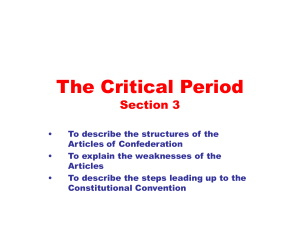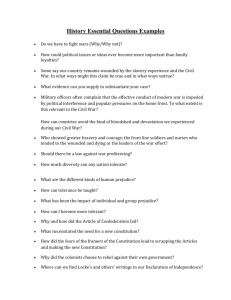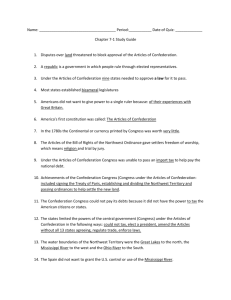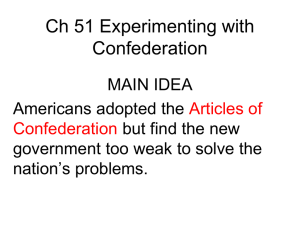Grading the Articles of Confederation Worksheet
advertisement
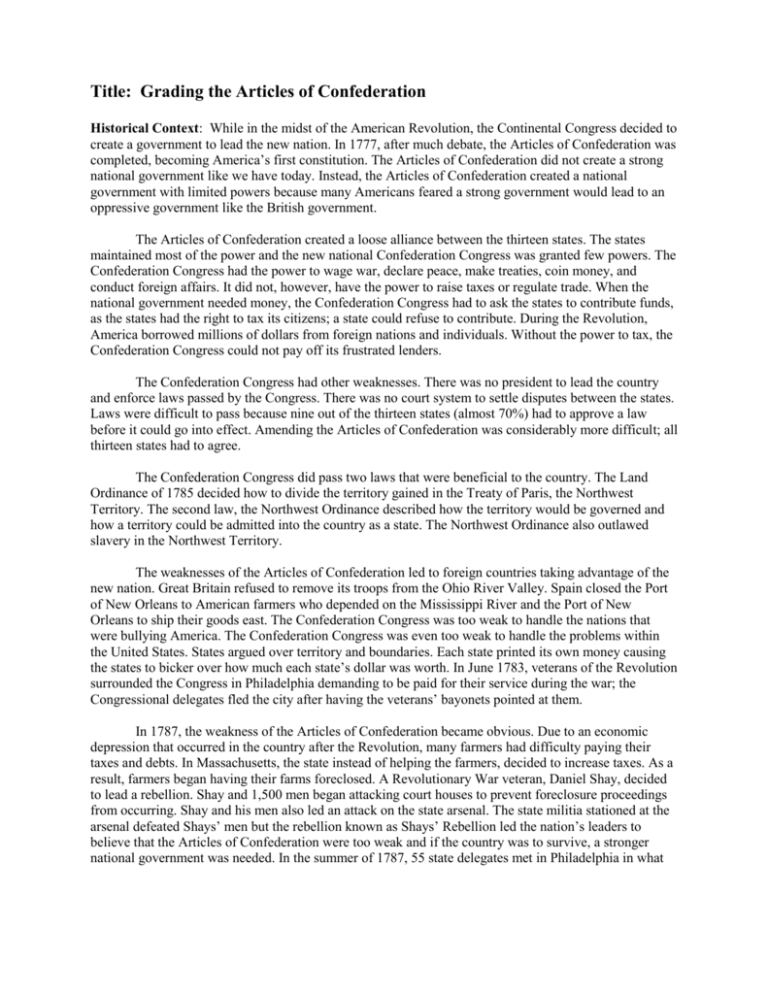
Title: Grading the Articles of Confederation Historical Context: While in the midst of the American Revolution, the Continental Congress decided to create a government to lead the new nation. In 1777, after much debate, the Articles of Confederation was completed, becoming America’s first constitution. The Articles of Confederation did not create a strong national government like we have today. Instead, the Articles of Confederation created a national government with limited powers because many Americans feared a strong government would lead to an oppressive government like the British government. The Articles of Confederation created a loose alliance between the thirteen states. The states maintained most of the power and the new national Confederation Congress was granted few powers. The Confederation Congress had the power to wage war, declare peace, make treaties, coin money, and conduct foreign affairs. It did not, however, have the power to raise taxes or regulate trade. When the national government needed money, the Confederation Congress had to ask the states to contribute funds, as the states had the right to tax its citizens; a state could refuse to contribute. During the Revolution, America borrowed millions of dollars from foreign nations and individuals. Without the power to tax, the Confederation Congress could not pay off its frustrated lenders. The Confederation Congress had other weaknesses. There was no president to lead the country and enforce laws passed by the Congress. There was no court system to settle disputes between the states. Laws were difficult to pass because nine out of the thirteen states (almost 70%) had to approve a law before it could go into effect. Amending the Articles of Confederation was considerably more difficult; all thirteen states had to agree. The Confederation Congress did pass two laws that were beneficial to the country. The Land Ordinance of 1785 decided how to divide the territory gained in the Treaty of Paris, the Northwest Territory. The second law, the Northwest Ordinance described how the territory would be governed and how a territory could be admitted into the country as a state. The Northwest Ordinance also outlawed slavery in the Northwest Territory. The weaknesses of the Articles of Confederation led to foreign countries taking advantage of the new nation. Great Britain refused to remove its troops from the Ohio River Valley. Spain closed the Port of New Orleans to American farmers who depended on the Mississippi River and the Port of New Orleans to ship their goods east. The Confederation Congress was too weak to handle the nations that were bullying America. The Confederation Congress was even too weak to handle the problems within the United States. States argued over territory and boundaries. Each state printed its own money causing the states to bicker over how much each state’s dollar was worth. In June 1783, veterans of the Revolution surrounded the Congress in Philadelphia demanding to be paid for their service during the war; the Congressional delegates fled the city after having the veterans’ bayonets pointed at them. In 1787, the weakness of the Articles of Confederation became obvious. Due to an economic depression that occurred in the country after the Revolution, many farmers had difficulty paying their taxes and debts. In Massachusetts, the state instead of helping the farmers, decided to increase taxes. As a result, farmers began having their farms foreclosed. A Revolutionary War veteran, Daniel Shay, decided to lead a rebellion. Shay and 1,500 men began attacking court houses to prevent foreclosure proceedings from occurring. Shay and his men also led an attack on the state arsenal. The state militia stationed at the arsenal defeated Shays’ men but the rebellion known as Shays’ Rebellion led the nation’s leaders to believe that the Articles of Confederation were too weak and if the country was to survive, a stronger national government was needed. In the summer of 1787, 55 state delegates met in Philadelphia in what became the Constitutional Convention; the Articles of Confederation was abolished and a new plan of government was created to replace it: The United States Constitution. Correlation to NYS Grades 7/8 Social Studies Core Curriculum: Unit Four: Experiments in Government I. The Articles of Confederation and the Critical Period Suggested Timeframe: One class period Materials and Resources: Worksheet – “School of Governments Report Card” (attached) Classroom notes and/or textbook Student Objectives: Students will be able to: Grade the effectiveness of the Articles of Confederation Explain their reasons for assigning the Articles of Confederation its grades Generate suggestion to improve the Articles of Confederation. Teaching Strategies and Methodologies: 1. This activity is a review for a quiz or test on the Articles of Confederation. In class on the day before the examination, provide students with a copy of the Articles of Confederation Report Card (attached). 2. Tell the students that they will be teachers at the “School of Governments” and it is report card time. It is their job to grade a student named the Articles of Confederation. The Articles of Confederation takes several courses and for each course they have to assign a grade. After assigning a grade for a course, the students will also have to explain why they chose the grade; they must use historical facts for the explanation. They also need to make a suggestion on how the Articles of Confederation can improve in that course. The students may use their notes or textbook to help them complete the assignment. As a class go over the different courses the Articles of Confederation takes and go over the goals for each course. Stress that the grade assigned should reflect how well the Articles of Confederation met the course goals. 3. Allow 10-15 minutes for students to assign their grades and write their suggestions. Move around the room to monitor students; if a student is assigning grades that are not correct, then individual guidance is necessary. 4. After students are finished, have a class discussion to create a class report card for the Articles of Confederation. For each course, call on students to state the grade they assigned and why. After the discussion, take a class vote on what grade should be assigned for the course. Repeat process for each course taken by the Articles of Confederation. 5. After the class report card is finished, ask the students for suggestions to improve the Articles of Confederation. Most classes will say that the Articles of Confederation has to go to summer school and the teacher will tell them that the Articles of Confederation will go to summer school in 1787 in Philadelphia. At summer school, teachers like George Washington, Benjamin Franklin, and James Madison will attempt to improve the Articles of Confederation, but ultimately they decided to expel the Articles of Confederation. Evaluation/Assessment: As an informal assessment, monitor the students as they assign their grades. It is fairly obvious to determine if a student understands the strengths and weaknesses of the Articles of Confederation by the grades the student assigns. This activity is good feedback to which students need extra assistance in order to pass an examination on the Articles of Confederation. For a formal assessment, the teacher may administer a quiz on the Articles of Confederation About the Author: Kathy Velasco is a 7th grade teacher at Wilbur H. Lynch Middle School in Amsterdam, NY. The School of Governments Report Card Student Name: Articles of Confederation Subject Area Raising Taxes Course Goal: Raise enough taxes to maintain the government, fund an army, and pay for debts. Passing Laws: Course Goal: Create a system for passing laws that is fair and not too difficult. Amending Constitutions Course Goal: Create a process for amending the constitution. The process should not make amending impossible. Handling National Affairs Course Goals: Maintain order in the country; earn respect of states and citizens so they follow laws. Pay off debts to citizens. Handling Foreign Affairs Course Goals: Gain respect in the world. Create fair trade agreements. Create treaties that favor your country. Pay off foreign debts. Organizing A Government Course Goals: Create a strong central government; Have a strong leader; Create a court system to handle disputes between the states. Handling of the Northwest Territory Course Goals: Create a system for governing and maintaining the land gained from the Treaty of Paris. Create a system to make the territories states. Grade Reason for grades/Suggestions

